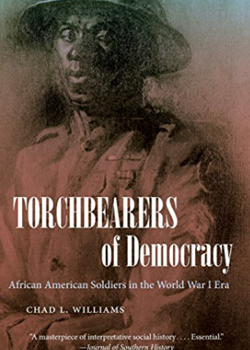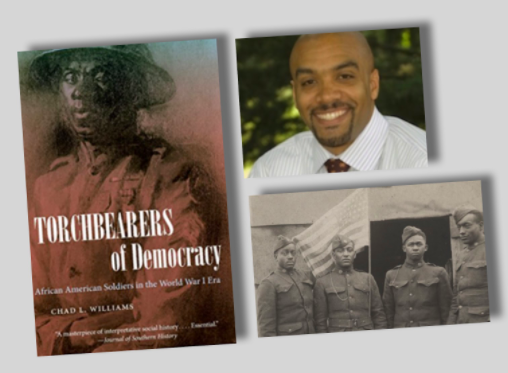Torchbearers of Democracy. African American Soldiers in the World War I Era by Chad L.Williams
- Home
- World War I Book Reviews
- Torchbearers of Democracy. African American Soldiers in the World War I Era by Chad L.Williams

472 pp., 6.125 x 9.25, 18 halftones, notes, bibl., index
PAPERBACK ISBN: 978-1-4696-0985-0
Published: August 2013
The University of North Carolina Press (2010)
EBOOK ISBN: 978-0-8078-9935-9
Published: September 2010
Awards and Distinctions
2011 Liberty Legacy Foundation Award, Organization of American Historians
A 2011 Choice Outstanding Academic Title : Choice Reviews gives subscribers access to a comprehensive archive of 200,000+ reviews brought together over 25 years. An Introduction to Choice.

Chad L. Williams is associate professor of African and Afro-American studies at Brandeis University.
This is an important, distinctive and scholarly exposition of an important confluence of events that has had repercussions throughout the 20th century and beyond. When African American’s volunteered to serve, or received the draft, during the First World War they did so against a background of Jim Crow segregation, state sponsored suppression, fear, injustice and violence. Their hope was that by showing they could serve in France ‘in defence of democracy’ as citizens and men under the United States flag that on their return they would be given greater freedom, more opportunities and protection under the law. Far from it, returning uniformed African Americans faced even greater, violent suppression and injustice.
‘African American’ is the preferred descriptor for a population otherwise defined by their black skin colour, sub-Saharan African roots and the long challenged and now thoroughly eschewed term ‘Negro’ with its roots in slavery. Although just a short period in the early part of the Century, the author Chad Williams considers the First World War, which for Americans can be counted in months rather than years as ‘one of the most significant periods in African American history’. (p.9).
‘Torchbearers for Democracy’ begins by placing African American’s in an historic, legal and geographic context so that we have an idea of the scale and depth of segregation, disenfranchisement, job discrimination, racial violence in the USA at the time. According to Williams ‘racial violence and the general disregard for black life … infected the entire social, economic, and cultural fabric of the nation.’ (p.17) From the top, to the very bottom, as evidenced by the words of President Wilson, a white supremacist and race hypocrite, who could say for the record that ‘The World must be made safe for democracy’ while supporting segregation and Jim Crow in the south of the country. (p.27)
Racial denigration was systemic, with the America War Department itself believing that African American soldiers ‘lacked the required attributes of manhood - mental sturdiness, self-control, objectivity - to become officers.’ (p.39) And that paternalistically, as if that were an excuse, only white officers, not dissimilar to the British regarding the Indian Army, could manage black troops and instil discipline. With a commitment to war pending President Woodrow Wilson forced the country’s only African American senior officer, Colonel Charles Young into retirement which ‘ominously foreshadowed the militaries' concerted efforts to devalue and discredit African American officers and soldiers under their command’. (pp 46-48)
290,527 African American’s enlisted, but they would be segregated and used primarily for labour. Those selected to go through officer training were, to put it bluntly, culled ruthlessly to keep their numbers down and leave the impression that only a fraction warranted officer status. The War Officer continued to blunder when ignoring advice about sending African Americans from the North of the country to the South for training. And having put them there ‘White officers with the authority to “kill the first nxxxxx that don’t do as he is told”. (p.85) As a result, “black servicemen fought a war, often for their very survival, before even setting foot on European soil’. (p.103)
The war inspired the optimism of many African American and race activists stoked the fires of their democratic sensibilities, and gave them hope that through patriotic sacrifice reform was indeed possible. (p.77)
The American Army Command were unwilling to countenance any opportunity for an African American to give orders to a white soldier, let alone serve along side him other than in a subservient or labouring role. On American soil African American soldiers were dispersed rather than training together so that there were always outnumbered two to one, white to black.
Friction was expected but advice not heeded regarding sending African American guardsmen from the North to the South where racial tensions would be greatest. ‘Groomed for failure’.
In France the 309th, 370th, 371st and 372nd Infantry Regiments were incorporated into the French Military. Their AEF equipment taken away and replaced with French weapons - rifles, carbines, machine guns, automatic rifles, pistols, helmets, gas masks and knapsacks.’ (p.120) Leaving the 93rd ‘better prepared for combat than many of the AEF divisional counterparts’.
Britain were complicit in this as the 92nd Division, comprising African American troops would have been trained by the BEF but for the intervention of Minister of War Lord Milner = a committed white supremacist, objected. (p.121) After all, colonial black South Africans had been limited to labour, so men other men of African descent could hardly been seen baring arms.
29 April 1918
369th Took command of five miles of front + French 16 Division west of the Argonne Forest.
13 May 1918 the tale of Needham Roberts and Henry Johnson of the 369th in an isolated 5 man observation post 2:30am a German raiding party attacked. (p.125)
77 black officers of the 372nd were brought before efficiency boards and transferred out of the regiment on spurious grounds. Manipulated test scores of black artillery officers at Camp Taylor in Kentucky so that only 33 received commissions. P.133
“The treatment meted out on us violated every principle of Army regulations, Army procedure and tradition and was visited on us solely in an attempt on the part of the white officers to humiliate us and destroy our prestige as officers in front of the French instructors, the white soldiers and even the German prisoners''. (130) Houston ‘Saving the World for Democracy. Pittsburgh Courier, 14 September 1940 (p.134)
Poisonous atmosphere and low moral. (p.135).
The history of the AEF in France is a story of ‘an endless array of blunders’ (p.139) with Pershing guilty of a series combat blunders. The Meuse-Argonne operation revealed Pershing to be both naive and dangerously overconfident in his handling of the AEF. (p.136).
Lacking proper training and advanced preparation American soldiers struggled with their crash course in the horrors of modern warfare and performed with mixed and sometimes outright disappointing results. (p.152)
“White racists reasoned that the black race could ‘never achieve full inclusion into American democracy - because of their inferiority and lack of manliness’. (p.141)
‘African American soldiers continued to stand as embodiments of patriotism, sacrifice, and the prospect of social change, but this idealism was tempered by their constant battles with abuse, insult, and slander’. (p.143).
The African Diaspora or the West African, East African, South African, Sub-Saharan or Central African Diaspora … Diaspora - a dispersal of people from their original homeland. Millions of people of African descent scattered throughout the globe as a result of various streams of movement and resettlement .
French Colonial troops from Algeria and Morocco, Tunisia fought at the Battle of the Marne, September 1914. In all, there were 34,000 Moroccans from August 1914 and 206,000 Algerians used by the end of the War. (p.151)
In France, raised in Senegal, Mangin believed in ‘La Force Noire’ where “Republican universalism fused with colonial racial ideology to justify the employment of African troops’. (35) Mangin, La Force Noire.
Racism was systemic.
7 Aug 1918 infamous memo titled ‘On the Subject of Black American Troops’ was issued which - “with stunning bluntness … offered a primer in American racism and how to apply its logic to the treatment of black soldiers in France’ (p.160)
Injustice / Brutality
Unfair execution of 19 year old William Buckner 313th Labor Battalion p.170-172 + Georgette Thiebaux 23 years old (she had wanted his watch) Arrentieres, 2 July 1918
Execution approved by General John Pershing and President Woodrow Wilson (108) Hanged 6 September 1918
13 December 1918
Croix de Guerre bestowed on the 93rd Division 365th
17 December 1918
Croix de Guerre, Distinguished Service Cross and the Médaille Militaire bestowed on the 372nd Infantry Regiment
After the War and the War At Home
Political Machinations
19 February 1919 The Pan African Congress
At least 11 African American Veterans were lynched in 1919 including:
16 Dec 1918 lynching of former soldier recently demobbed Charles Lewis who had spent his war at Camp Sherman, Ohio.
14 March 1919 Bud Johnson tied to a tree and burned to death.
30 September 1919 ‘Program’ of 100s Hop Spur, Phillips County, Arkansas (p.232)
The legal lynching of Edgar Caldwell, 15 December 1918 when he obtained a pass and boarded a local streetcar in Anniston in Calhoun County, Alabama 20 July 1920 hanged. (pp.241-244)
Autumn 1920 Julius Perry encouraged African American to register to vote - he ended up lynched and many dead.
30 May 1921 Tulsa riots with African American veterans trying to defend their community. pp 257-260 (Chad Williams, Torchbearers of Democracy)
100,000 African American Servicemen relocated to the north on demob.
Foundation of the League for Democracy and Osceola MacLaine's role.
‘Desires to Court Martial Colonel Greer of 92nd Division for ‘disloyalty to their country and insidious anti-negro propaganda’. (p.275)
NAAC membership increased from 9,200 in 1918 to 62,200 in 1919.
Military training and a self-evident willingness to lay down his life for a good cause made the African American veteran well suited and if necessary risking his life against any lynch mob p.284
The road to redemption for African Americans has been a long one, the issue of racism still a pernicious element in American society, but on 25 June 1941, as much as a result of the work of the First Lady Eleanor Roosevelt, the President issued Executive order 8802 banning racial discrimination in defence industries and creating the Fair Employment Practices Commission.
Review by Jonathan Vernon
Further Enquiry
Visit the Facebook page ‘Torchbearers of Democracy’ : Includes videos, images and comments.
Follow the author on Twitter @Dr_ChadWilliams.
Mentioned in Dispatches Podcast
African American Serviceman during World War One
Additional Western Front Association Book Reviews
Ely Green ‘Too Black, Too White’
The Unknown Soldiers : Black American Troops in World War One
Rayford W. Logan : The Dilemma of the African American Intellectual
Paris Noir : African Americans in the City of Light by Tyler Stovall
Scotts Official History of the American Negro in World War 1
The World's War by David Olusoga
Freedom Struggles : African Americans and World War One by Adriane Lentz-Smith
Two Colored Women with the American Expeditionary Forces
Further Reading
David M Kennedy ‘Over Here’. OUP 25th Anniversary Edition
‘The Complete History of the Colored Soldiers in the World War enc. John A Jamison
(Available as a PDF)
J Cooper ‘The Great War and American Memory’
Black Bolshevick. Autobiography of a Black American Communist by Harry Haywood
Richard S Fogarty, Race and War in France: Colonial Subjects in the French Army, 1914–1918
The Black Swallow of Death, P.J.Carisella & James W.Ryan Hardcover. Marlborough House, 1972.





